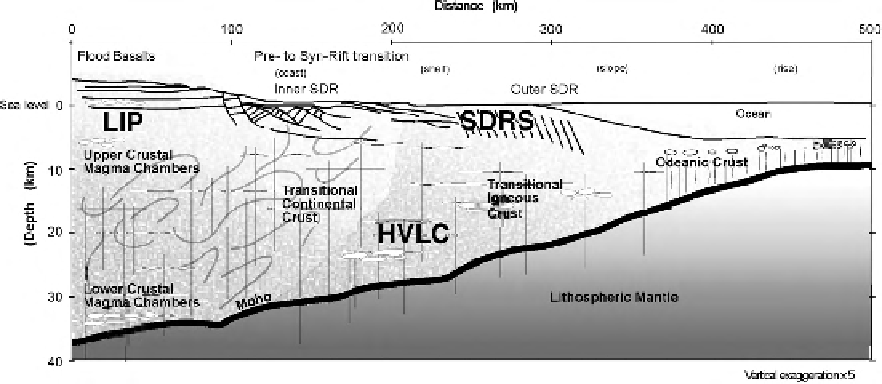Geoscience Reference
In-Depth Information
Figure 10.42.
A schematic cross section of a volcanic rifted margin, showing the
flood volcanism (large igneous province, LIP), seaward-dipping reflectors (SDR) and
the high-velocity lower crust (HLVC). (From Menzies
et al
.(2003).)
melting can result in melt production at rifted margins but, for large amounts of
melt to be generated, the potential temperature of the underlying mantle needs to
be higher than normal (Section 7.7).
Many volcanic continental margins are associated with continental flood
basalts, or 'large igneous provinces' (LIP). It has been estimated that more than
2
10
6
km
3
of basalt was extruded onto the rifting margins in the northern North
Atlantic over a period of about 2 Ma and that perhaps twice as much igneous rock
was added to the lower crust (Fig. 10.42). The extruded volcanic rocks show up
on reflection profiles as a set of seaward-dipping reflectors. A thick lower crust
with an abnormally high P-wave velocity (7.1-7.6 km s
−
1
)isinterpreted as the
igneous rocks which were added to the lower crust. The volcanism that took place
along the northern North Atlantic margins seems to have been caused by elevated
temperatures in the asthenosphere. Were the temperature of the asthenosphere
100-150
◦
C higher than normal, rapid rifting would generate large quantities of
melt (McKenzie and Bickle 1988). Proximity to the hot mantle currently located
beneath Iceland was probably the reason for the elevated temperatures beneath the
northern North Atlantic at the time of rifting. However, numerical modelling has
shown that rifting can induce unstable small-scale mantle convection beneath the
continental margin (Boultier and Keen 1999). If the mantle becomes dehydrated
when melt is removed, such localized convection can result in some increase in
production of magma at the margin, even with normal mantle temperatures, and
matches some observations along the North American margin. In addition, since
the convection may continue beneath the margin for tens of millions of years after
×

